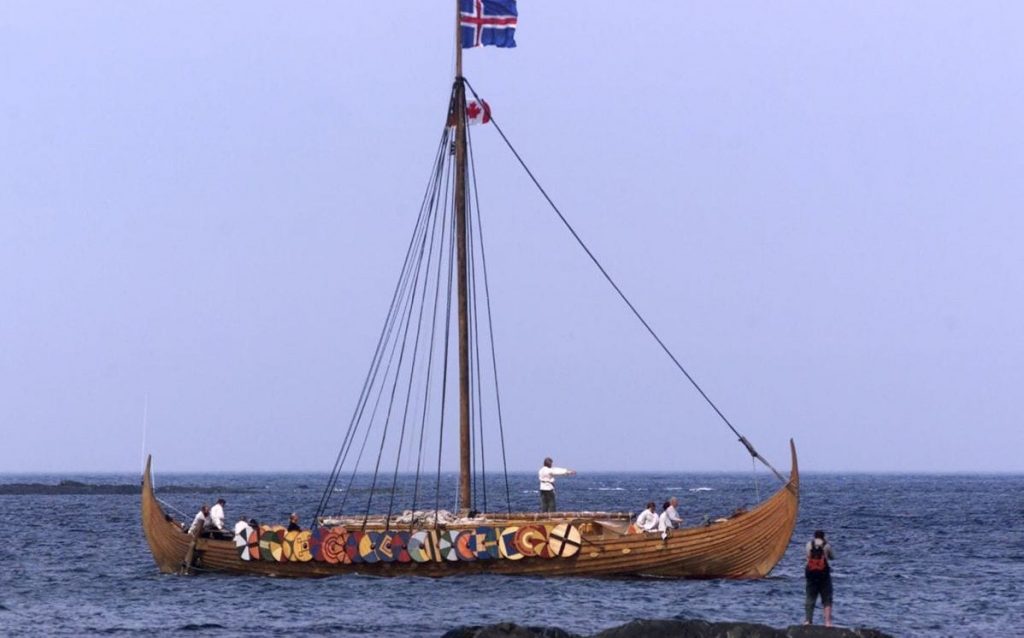Vikings crossed the Atlantic a thousand years before Columbus

Long before Columbus crossed the Atlantic, eight half-timbered, grass-covered buildings stood on a porch above a swamp and river on the northern tip of the Canadian island of Newfoundland. Evidence that the Vikings first arrived in the New World.
But precisely when the Vikings traveled to establish the settlement of L’Anse aux Meadows has not been clear – until now.
Scientists said that a new type of dating technology that uses an ancient solar storm as a reference point revealed that the settlement was occupied in AD 1021, exactly a thousand years ago and 471 years before Columbus’ first voyage. This technique was used on three pieces of wood cut for the settlement, all referring to the same year.
The journey of the Vikings represents many milestones for humanity. The settlement provides the oldest known evidence of a transatlantic crossing. It also marks where the world was finally surrounded by humans, who entered North America thousands of years ago via a land bridge that connected Siberia to Alaska.
“We must commend these northern Europeans for being the first human community to cross the Atlantic,” said geologist Michael De of the University of Groningen in the Netherlands, who led the study published in the journal Nature.
The Vikings, or people of the North, were sailors with Scandinavian homelands: Norway, Sweden and Denmark. They ventured throughout Europe, sometimes colonizing and at other times trading or raiding. They possessed extraordinary skills in shipbuilding and navigation and established settlements in Iceland and Greenland.
“I think that It is fair to describe the journey as a journey of discovery and search for new sources of raw materials“Many archaeologists believe that the main motive for research in these new areas is the discovery of new sources of wood in particular. It is generally believed that they came from Greenland, where timber suitable for construction is extremely rare,” De said.
Their wooden boats, called longboats, were powered by sails and oars. One of the surviving examples, called the Oseberg ship, is about 70 feet (21.6 meters) long.
The Viking Age is conventionally defined as 793-1066 AD, which gives a wide range for when to cross the Atlantic. Ordinary radiocarbon dating, which determines the age of organic materials by measuring their content of a particular radioactive isotope of carbon, has turned out to be very inaccurate as yet L’Anse aux Meadows, discovered in 1960, although there is a general belief that it was eleventh century.
The new dating method is based on the fact that solar storms produce a distinct signal of radiocarbon in the tree’s annual growth rings. It is known that a great solar storm, an explosion of high-energy cosmic rays from the sun, occurred in AD 992.
University of Groningen archaeologist Margot Kuitems, first author of the book: A Study, said.
“It wasn’t the local Aboriginals that felled the wood because there was evidence of sheet metal that they didn’t have,” Dee said.
“The length of the occupation remains unclear, although it may have been a decade or less, and perhaps 100 Nordic people were present at any one time,” De said.
Their structures are similar to those of the North in Greenland and Iceland.
An oral history called Icelandic sagas depicting the presence of the Vikings in the Americas, written centuries later, describes a leader named Leif Erikson and a settlement called Vinland, as well as violent and peaceful interactions with the locals, including the capture of slaves.
De said the date of 1021 roughly corresponds to the tales of the epic, adding: “So the question arises, how much of the adventures left in the saga is correct? “
Give

“Travel enthusiast. Alcohol lover. Friendly entrepreneur. Coffeeaholic. Award-winning writer.”





